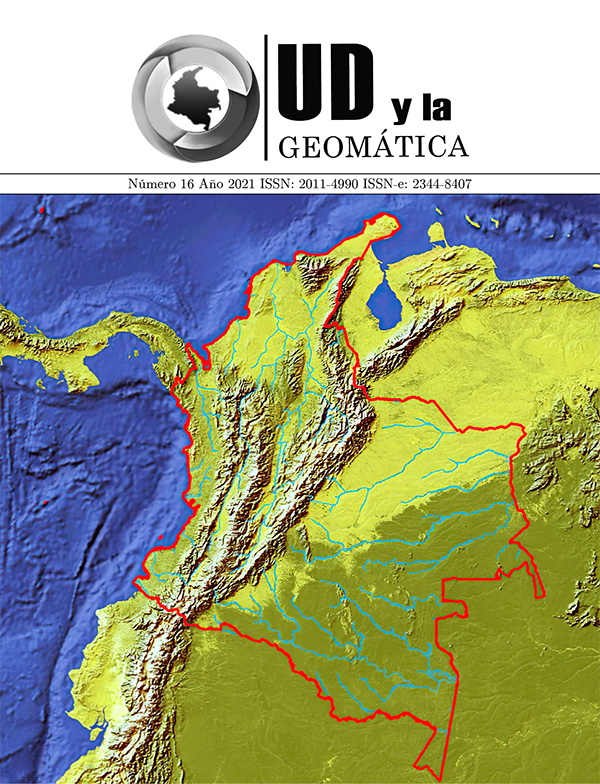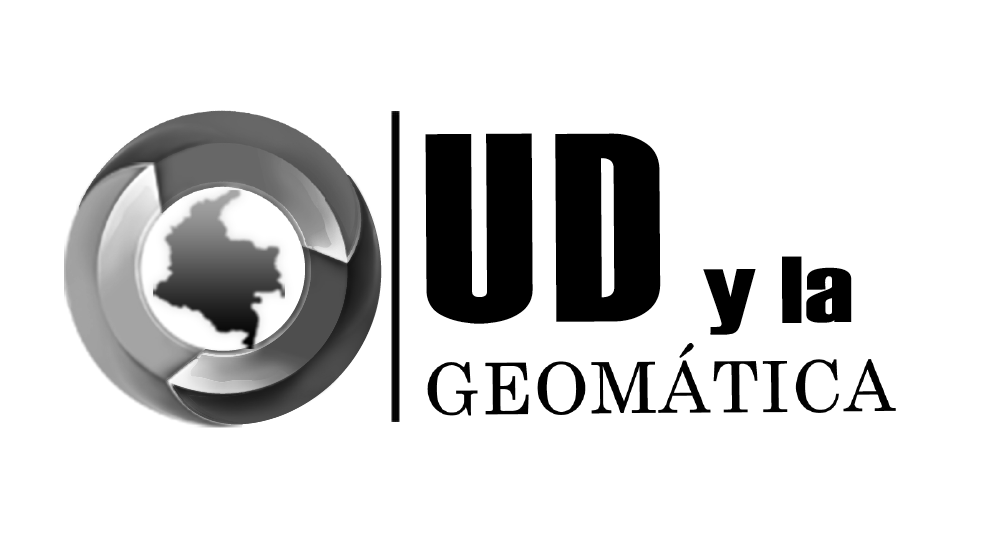DOI:
https://doi.org/10.14483/23448407.15269Publicado:
2020-12-14Número:
Núm. 16 (2021)Sección:
Artículo de investigación científica y tecnológicaClasificación supervisada contextual de Markov empleando imágenes multiespectrales LandSat 8 OLI y Sentinel 2A
Supervised Markov contextual classification using LandSat 8 OLI and Sentinel 2A multispectral images
Descargas
Resumen (es)
El presente artículo está orientado a mostrar el desarrollo y los resultados de la implementación de un método contextual de clasificación supervisada en imágenes multiespectrales LandSat 8 OLI y Sentinel 2A a partir de la teoría de los Campos Aleatorios de Markov. Este método se implementó y desarrollado en el software MatLab empleando la herramienta Mapping Toolbox lo que permitió conservar el sistema de referencia espacial. Se emplearon como insumo recortes de las 5 bandas (Azul, Verde, Rojo, Infrarrojo Cercano e Infrarrojo Medio) de los dos sensores LandSat 8 y Sentinel 2A de los días 22 y 23 de diciembre del 2018 respectivamente sobre un área comprendida en municipios de Puerto López, San Carlos de Garagoa, y Villavicencio. Como resultado se obtuvieron dos mapas de clasificación con las 5 coberturas predominantes de la zona y un índice Kappa mayor a 0,5, el cual es mayor que el obtenido con los métodos de clasificación supervisada de KNN y Malahanobis - ERDAS validados en el proyecto.
Resumen (en)
This article aims to show the development and results of the implementation of a shortcut method of supervised classification on multispectral LandSAT 8 OLI and Sentinel 2A from the theory of Markov random fields. This method was implemented and developed software MatLab using the tool Mapping Toolbox which allowed to preserve the spatial reference system. They were used as input cuts of 5 bands (blue, green, red, near infrared and infrared medium) of the two sensors LandSAT 8 and Sentinel 2A of the 22nd and 23rd of December of 2018 respectively over an area included in the municipalities of Puerto López, San Carlos of Garagoa, and Villavicencio. As a result, two classification maps were obtained with the 5 predominant coverage of the area and a Kappa index greater than 0.5, which is higher than that obtained with the supervised classification methods of KNN and Malahanobis - ERDAS validated in the project
Referencias
Anderson, J. R., Hardy, E. E., Roach, J. T., Witmer, R. E., & Peck, D. L. (1976). A Land Use And Land Cover Classification System For Use With Remote Sensor Data. A Revision of the Land Use Classification System as Presented in U.S. Geological Survey Circular 671, 964, 41.
Ariza, A., J, S. G., B, S. R., & Ramírez, D. (2013). Desarrollo de un modelo de corrección de imágenes de satélite para inundaciones: (CAIN - Corrección Atmosférica e Índices de Inundación) Alexander.
Besag, J. (1974). Spatial interaction and the statistical analysis of lattice systems. Journal of the Royal Statistical Society. Series B ( …, 36(2), 192–236. https://doi.org/10.2307/2984812
Blaschke, T., Lang, S., Lorup, E., Strobl, J., & Zeil, P. (2000). Object-oriented image processing in an integrated GIS/remote sensing environment and perspectives for environmental applications. Environmental Information for Planning, Politics and the Public, 2, 555–570.
Borras, J., Delegido, J., Pezzola, A., Pereira, M., Morassi, G., & Camps-Valls, G. (2017). Clasificación de usos del suelo a partir de imágenes Sentinel-2. Revista de Teledetección, (48), 55. https://doi.org/10.4995/raet.2017.7133
Chuvieco, E. (2008). Teledetección ambiental: La observación de la Tierra desde el Espacio. Entorno Geografico, 3, 575. Retrieved from http://www.slideshare.net/alinabelen/savedfiles?s_title=teledeteccion-ambiental-listo&user_login=jaiflo7503
Cohen, J. (1960). A coefficient of agreement for nominal scales, XX(1), 37–46.
Cui, Z., Wang, Y., Gao, X., Li, J., & Zheng, Y. (2016). Multispectral image classification based on improved weighted MRF Bayesian. Neurocomputing, 212, 75–87. https://doi.org/10.1016/j.neucom.2016.03.097
Derin, H., Elliott, H., Cristi, R., & Geman, D. (1984). Bayes Smoothing Algorithms for Segmentation of Binary Images Modeled by Markov Random Fields. IEEE Transactions on Pattern Analysis and Machine Intelligence, PAMI-6(6), 707–720. https://doi.org/10.1109/TPAMI.1984.4767595
Dong, Y. D. Y., Forster, B., & Milne, a. (1998). Evaluation of radar image segmentation by Markov random field modelwith Gaussian distribution and Gamma distribution. IGARSS ’98. Sensing and Managing the Environment. 1998 IEEE International Geoscience and Remote Sensing. Symposium Proceedings. (Cat. No.98CH36174), 3(5), 1617–1619. https://doi.org/10.1109/IGARSS.1998.691645
García, A., Martínez, G., Nuñez, E., & Guzmán, A. (1998). Clasificación supervisada, inducción de arboles de decisión, algoritmo kd. Proc. Simp. Int. de Comp. CIC, 98, 602–614.
Gleich, D. (2012). Markov random field models for non-quadratic regularization of complex SAR images. IEEE Journal of Selected Topics in Applied Earth Observations and Remote Sensing, 5(3), 952–961. https://doi.org/10.1109/JSTARS.2011.2179524
Guijarro Mata-García, M. (2010). Identificación de texturas en imágenes naturales : nuevas estrategias locales y globales.
Landis, J. R., & Koch, G. G. (1977). The measurement of observer agreement for categorical data. Biometrics, 33(1), 159–174.
Lang, R., Shao, G., Pijanowski, B. C., & Farnsworth, R. L. (2008). Optimizing unsupervised classifications of remotely sensed imagery with a data-assisted labeling approach. Computers & Geosciences. https://doi.org/10.1016/j.cageo.2007.10.011
Li, S. (2001). Markov Random Field Models in Computer Vision. Springer Verlag, 2263(4).
Liao, W., Tang, J., Rosenhahn, B., & Yang, M. Y. (2015). Integration of Gaussian Process and MRF for Hyperspectral Image Classification, 3–6.
López, J. P. A., Valero, O. J. E., & Escorcia, J. L. H. (2004). Validación de una Metodología de Clasificación de Imágenes Satelitales en un entorno Orientado a Objetos. Ingeniería, 10(1), 61–69.
Lopez, E. (2007). Segmentacion de Coberturas de la tierra espectralmente similares empleando CAM, caracteristicas y geometria estocastica.
Lorette, a, Descombes, X., & Zerubia, J. (2004). Texture Analysis through a Markovian Modelling and Fuzzy Classification : Application to Urban Area Extraction from Satellite Images. International Journal of Computer Vision, 36(3), 221–236.
Mather, P., & Tso, B. (2009). Classification methods for remotely sensed data.
Mena, J. (2003). Extracción automática de entidades cartográficas lineales en zonas rurales o semiurbanas a partir de imágenes satélite en color de alta resolución.
Paragiosl, N., & Deriche, R. (2000). Coupled Geodesic Active Regions for Image Segmentation : A Level Set Approach. Computer Vision, 224–240.
Perea, A. J., Meroño, J. E., & Aguilera, M. J. (2009). Clasificación orientada a objetos en fotografías aéreas digitales para la discriminación de usos del suelo. Interciencia, 34(9).
Plourde, L., & Congalton, R. (2003). Sampling method and sample placement: how do they affect the accuracy of remotely sensed maps. Photogrammetric Engineering and Remote Sensing, 69(3), 289–297. https://doi.org/0099-1112/03/6903–289$3.00/0
Zhan, Y., You, H., & Fuqing, C. (2013). Bayesian edge detector for SAR imagery using discontinuity-adaptive Markov random field modeling. Chinese Journal of Aeronautics, 26(6), 1534–1543. https://doi.org/10.1016/j.cja.2013.04.059
Cómo citar
APA
ACM
ACS
ABNT
Chicago
Harvard
IEEE
MLA
Turabian
Vancouver
Descargar cita
Licencia
La revista UD y la Geomática se encuentra bajo una licencia Creative Commons - 2.5 Colombia License.
Atribución - No Comercial - Sin Derivadas





